Francis T. Harmon, 1864 - 1946
by Brian Stevenson
last updated October, 2022
F.T. Harmon was a professional photographer who worked in Chicago during the first half of the twentieth century. He was also a skilled microscopist, and a long-time member and officer of the State Microscopical Society of Illinois. Harmon produced numerous photomicrographs (that is, photographic enlargements using a microscope) for commercial clients. He also made at least one microphotograph (i.e. a reduced-size photograph on a glass slide that requires a microscope to see): an image of the April 16, 1912 front page of the Chicago American newspaper that announced the sinking of the ship Titanic (Figures 1 and 2).
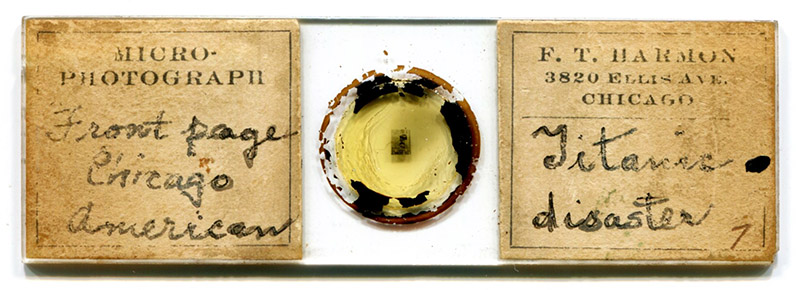
Figure 1.
A microphotograph slide by F.T. Harmon, of the front page of the April 16, 1912 issue of “The Chicago American”. This was over 60 years after J.B. Dancer and others created the microphotograph fad, which had largely died out by the end of the 1800s. Most likely, Harmon combined his skills as a photographer and microscopist to produce this as a novelty souvenir. The label with pre-printed “Micro-Photograph” and handwritten descriptions suggests that Harmon probably produced other such curiosity slides.
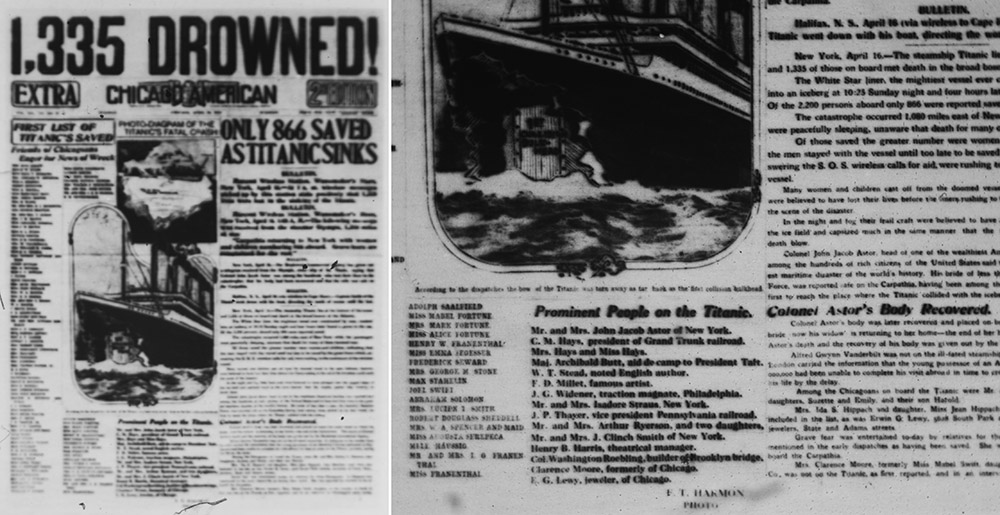
Figure 2.
The front page (left) and a detail (right) of F.T. Harmon’s microphotograph of the April 16, 1912 front page of the “Chicago American”. Harmon embedded his name in the negative, visible at the bottom of the right image. Photographed with a 3.5x (left) and a 10x (right) objective lens on a Leitz Ortholux II microscope.
Francis T. Harmon was born on April 14, 1864 in Peru, Illinois. He was the third child, and second son, of Martin and Isabella Jones Harmon. The 1860 US census listed Martin’s occupation as “barkeeper”. The father was likely the same Martin Harmon who served in the 141st Illinois Infantry and Vaughn’s Independent Battery of the Illinois Light Artillery during the US Civil War. Records indicate that Martin Harmon survived the war.
The family probably moved to Chicago after the war ended in 1865. The 1867 Directory of Chicago listed a Martin Harmon as a laborer in the Union Rolling Mills Company.
Father Martin disappeared from records between 1867 and the 1880 US census. Mother Isabella was listed as being a widow in 1880. The family then consisted of the mother, 15 year-old Francis who worked as a clerk, elder brother Henry who worked as a bookkeeper, a younger brother and a sister, and a boarder.
The first known evidence of Francis Harmon’s involvement with microscopy is an 1896 advertisement that he posted in the American Monthly Microscopical Journal (Figure 3). He sought to get rid of a slide cabinet and a number of microscope slides, a bull’s eye condenser, and a Zeiss ocular lens. He also wanted to sell off an apparatus for producing photomicrographs. Considering Harmon’s future profession, that might have been a less-than-adequate photomicrograph apparatus, which was replaced with a better device.
The 1900 US census recorded Francis as living with his mother and elder brother, and working as a “cashier”. They lived at 3820 Ellis Avenue, Chicago since at least 1896, and Francis Harmon lived in that home through the end of his life. In the 1910 census, Francis was reported to be a “photographer”.
Harmon had joined the State Microscopical Society of Illinois by this time. On October 8, 1910, he presented an address on “Photomicrography” to the society, which included a “specially constructed apparatus he used in taking the exquisite photographs which have given him a wide celebrity. A number of these were shown, both in ordinary finish and in natural-color photographs”.
Photomicrography became a major aspect of Harmon’s business. His work was featured in a diversity of books, magazines, and even a Ph.D. thesis (Figures 4 and 5). He widely advertising his custom production of photomicrographs, as well as lantern slides for use in public demonstrations.
Harmon and his work were featured in a 1926 article for Class: Industrial and Trade Advertising, on “Showing the goods under the microscope”. The piece included a picture of Harmon’s photomicrography setup (Figure 6). Along with examples of photomicrographs being put to good use in advertising qualities of abrasive materials, adhesive tapes, and cardboard containers, Harmon’s business was described:
“F.T. Harmon, who has a specially-equipped studio for making photomicrographs at 3820 Ellis avenue, Chicago, in explaining the process, said that almost any product can be pictured in this way. He showed the writer specimens of steel, wood and many other products which had been the subject of his microscopic lens. Although the bulk of his work has been for the medical profession, in picturing lurking bacteria and fragments of leaking lungs, he has a wide experience in other subjects, making pictures of the structure of various materials to substantiate patent claims and show technical men and processes they couldn't see but knew were going on.
Mr. Harmon emphasized the fact that a great part of the success of this work depends on the proper preparation of the subject.
‘A man came in one day’, said Mr. Harmon, ‘with a grinding bowl which he wanted magnified fifty times. When I explained to him that such a magnification would produce a picture of such size that he couldn't hang it on the wall in an ordinary room, he finally consented to let me photograph a fragment showing the structure of the material, which was what he really wanted’.
He pointed out that one of the essentials is preparing the subject so that it will present a flat surface to be photographed.
‘When you photograph mountains you have a surface that varies in depth as much as ten or more miles, but with the great reduction of a panorama miles in length to the size of a photographic plate, this difference is taken care of. On the other hand, when you make a great enlargement, every variation in depth, or distance from the lens to each part of the surface is magnified in direct proportion and consequently some of the surface will be out of focus and cause distortion’.
Mr. Harmon then showed a specimen of steel which he had photographed. It was polished and smooth, but in the camera showed an intricate grain very clearly. Sometimes the steel specimens are polished and then etched with acid to bring out certain characteristics. A specimen of steel, which was a fragment of a very fine file, showed clearly the hills and valleys, and because of the distortion due to the uneven surface, scarcely any grain was visible at all.
The apparatus for making photomicrographs is similar in appearance to a photo-engraver's camera, in miniature. A long bellows has at one end a ground glass behind the plate-holder, and for the convenience of the operator, the image on this is reflected in a mirror. At the opposite end is a microscope set on its back, with the small lens and object away from the camera. The usual place for the slide which hold the object to be photographed is easily adjustable to any position by means of thumb-screws. On the far side of the object an intense light is projected through the slide.
The illustration gives an idea of how the apparatus works. In effect it is like an ordinary camera, but with a microscope taking the place of the ordinary lens, and with the light projected from behind the object. The position of the light is reversed, however, with objects which are not translucent.
Enlargements, or magnifications almost any proportions, can be made, and the smaller the enlargement, the less effect has the surface, and the wider range of subjects that can be handled. Just as the number of diameter of magnification can be varied, so the number of uses can be varied. The possibilities of this process are infinite, and the process itself overcomes many limitations of language in technical descriptions.
It seems, too, that in this field men actually doing the work who are themselves scientists, and who take great pleasure in obtaining the best results from difficult subjects. Because of the highly technical nature of this department of photography, it would seem better to consult an expert in the preparation of the material to be photographed”.
Francis Harmon did not marry. The 1930 US census recorded that he and unmarried 72 year-old unmarried sister, Belle, lived at the old family home of 3820 Ellis Avenue, Chicago. As noted in advertisements, this was also Harmon’s business address. Francis Harmon died on April 15, 1946, in Chicago.

Figure 3.
An 1896 advertisement from F.T. Harmon, indicating that he was active in microscopy and photomicrography by that time. From “The American Monthly Microscopical Journal”.
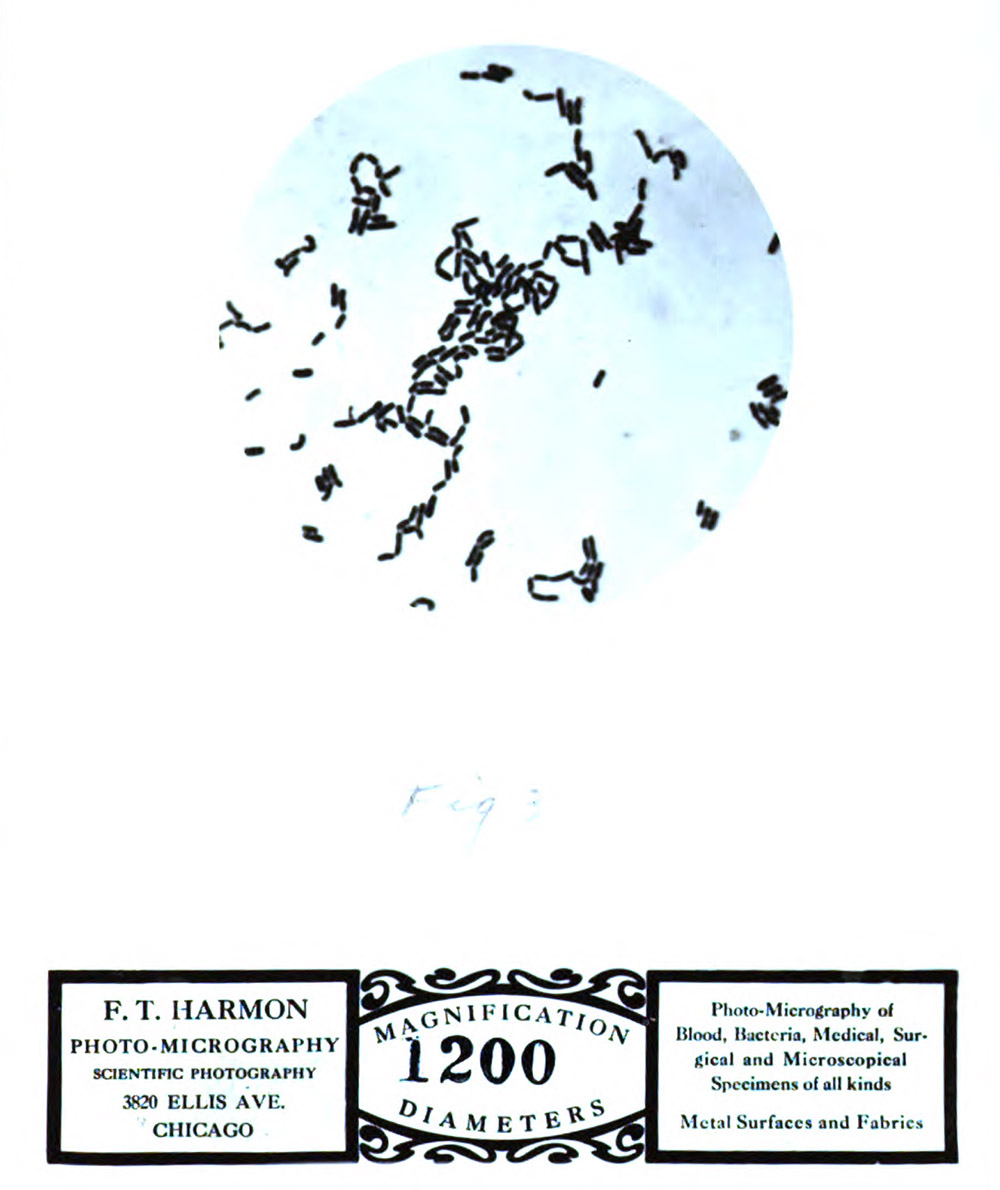
Figure 4.
Photomicrograph of “Gram positive bacillus”, prepared by F.T. Harmon, for the 1923 Ph.D. dissertation of Louis H. Braaflad, University of Chicago.
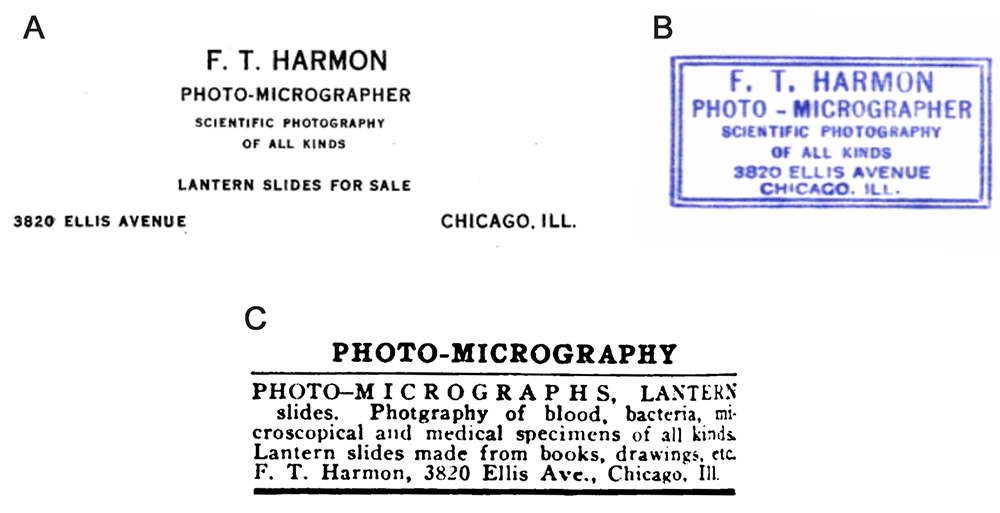
Figure 5.
Additional advertisements or production marks from F.T. Harmon. A. Advertisement from J. Deason’s “Practical Biology”, 1911. That book included this acknowledgement: “I am indebted to … Mr. F.T. Harmon, photomicrographer for some of his excellent photomicrographs of bacteria”. B. Production stamp that accompanied photomicrographs in Mariner and Hoskins 1913 “Report to Chicago Association of Commerce, Committee on Smoke Abatement and Electrification of Railway Terminals”. C. Advertisement from Journal of the American Medical Association, 1919.
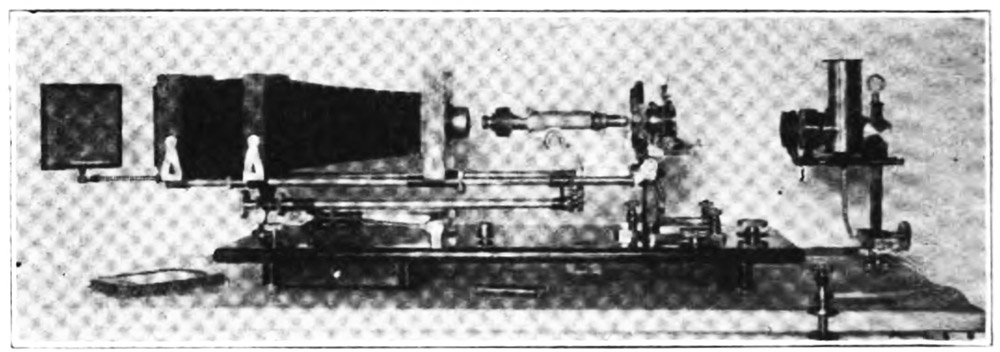
Figure 6.
Francis Harmon’s photomicrographic apparatus, as shown in a 1923 magazine article by R.T. Sanford.
Resources
The American Monthly Microscopical Journal (1896) Advertisement from F.L. Harmon, Vol. 17
Braafladt, Louis Henry (1923) The Effect of Kaolin on the Intestinal Flora in Normal and Pathological Condition, Ph.D. dissertation, Ogden Graduate School of Science, University of Chicago
Deason, J. (1911) Practical Bacteriology, Journal Printing Co., Kirksville, Missouri
Directory of Chicago (1867) “Harmon Martin, lab. Union Rolling Mills Co.", page 386
Journal of the American Medical Association (1919) Advertisement from F.L. Harmon, Vol. 73, advertisements page 32
Journal of the Photomicrographic Society (1925) Members: “E. (sic) T. Harmon, 3820, Ellis Avenue, Chicago, USA”, page 47
Mariner and Hoskins (1913) Report to Chicago Association of Commerce, Committee on Smoke Abatement and Electrification of Railway Terminals
Sanford, Russell T. (1926) Showing the goods under the microscope, Class: Industrial & Trade Advertising, Vol. 16, pages 84-88
Science (1910) The Microscopical Society of Illinois, page 200
Science (1914) The State Microscopical Society of Illinois, page 389
US census and other records, accessed through ancestry.com





